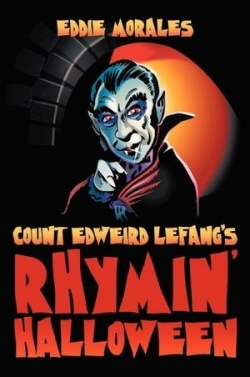Count Edweird LeFang's Rhymin' Halloween
The old saw about not judging a book by its cover comes to mind when a reader picks up poet Eddie Morales’s spooky Count Edweird Lefang’s Rhymin’ Halloween and sees a cartoonish vampire, more reminiscent of Count Dracula than Twilight‘s handsome Edward Cullen, with pointy incisors and blood-red eyes. Inside, the poems are printed in a Gothic font, which may inspire the reader to recite the poems aloud, as poems are meant to be read, and either shout them in menacing glee, if told from the point of view of a vampire or banshee, or whisper them in mournful tones, if a ghost or Frankenstein’s monster happen to be the narrators.
Once the reader starts to recite the poems, the power of the words takes over and the silly cover is forgotten. Count Lefang, who laments his vampire existence and his lost humanity, even as bloodthirst drives him to kill, narrates the first few poems. Subsequent poems are written in the voices of other archetypal creatures of darkness, including witches, ghouls, gremlins, skeletons, werewolves, and mummies. Morales dares to stray into rousing lyrical territory both in form and subject. Sonnet, sestina, rondeau redoublé, limerick, roundel, haiku, pantoum, terza rima, and ballad are fair game, and they get coupled with the characters of horror films. And the poems’ titles are just as fun as the verses themselves, such as “A Triolet to a Vampire’s Immortality,” “A Douzet from the Werewolf,” and “Ode to My Ghoulfriend.”
Stretching the boundaries of what counts as Halloween poetry, Morales ventures into ancient Greek myths of creatures like Medusa and historic Egyptian figures like Imhotep. The poet clearly enjoys experimenting with a sequel to Edgar Allan Poe’s “The Raven,” titled a “Murder of Ravens,” in which things don’t go much better for the tragic narrator. Some poems are funny, some are creepy, and some are sad, but all of them share an intensity and earnestness that demonstrate Morales’s respect for the poem as a form of art used to convey story, emotions, and ideas.
The author of two previous books of poetry, A Reason for Rhyme and The Suicide Sonnets, Morales is passionate about the rhyming form. In his introduction to Count Edweird Lefang’s Rhymin’ Halloween, he laments the dearth of rhyming verse in modern poetry, fearing it is becoming a lost art. If the poems in his new collection compel readers to seek out works by Poe or Mary Shelley or Bram Stoker, then mission accomplished.
Reviewed by
Olivia Boler
Disclosure: This article is not an endorsement, but a review. The publisher of this book provided free copies of the book and paid a small fee to have their book reviewed by a professional reviewer. Foreword Reviews and Clarion Reviews make no guarantee that the publisher will receive a positive review. Foreword Magazine, Inc. is disclosing this in accordance with the Federal Trade Commission’s 16 CFR, Part 255.

